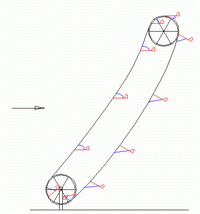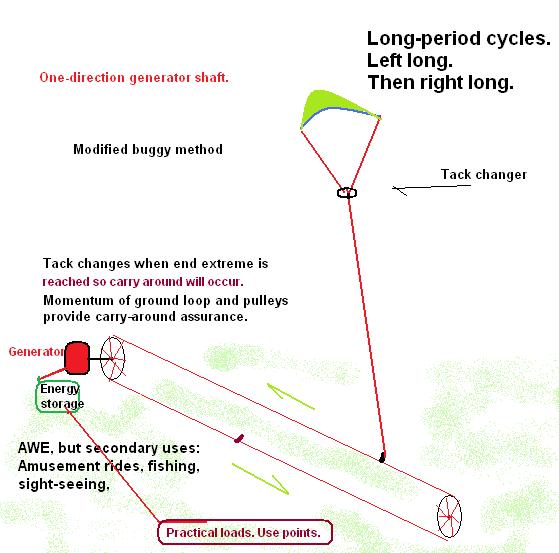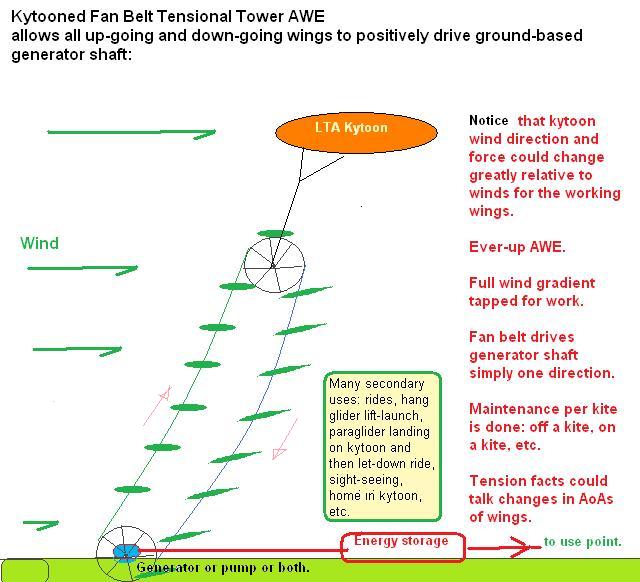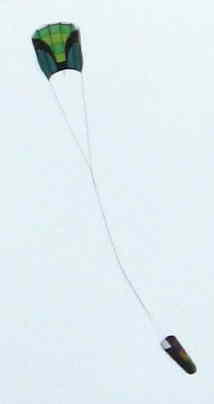|
Member-sent
notices |
||
| 1July2009 |
French Kite
Aerial Photography Unit, WWI ...video held by The Drachen Foundation. |
|
| 2July2009 | Our Wind-Powered Future: Will Congress make it possible, or stand in the way? | |
| 6July2009 |
Stem (Hybrid method within the larger family of wafting levers, rotating levers, rocking arms, oscillating levers, shaking handle, and TipBoom or Tipping Boom. The Stem method involves some out and in with some period of non-energy production. And blow starts, and 3-D onboard sensors.) KiteGen moves into "stem" tech Posted by Ugo Bardi on July 6, 2009 "EROEI = 375"* Energy return on energy invested index Thanks to Frank and also Dave Culp for sending notice: THEN SEE HIS JULY 12, 2009 ...HANDLING THE MANY QUESTIONS HE RECEIVED...AND A FURTHERING: by Ugo Bardi: We are delighted that he forwarded terms: "AWE" Airborne Wind Energy:
|
|
| 6July2009 | Hydrogen-based lighter-than-air kytoon (LTAK) "never-down" may aloft recharge its hydrogen from solar-radiation splitting of high-altitude water from water vapor . Water vapor. | |
| 7July2009 |
Open for discussion: "A key insight is that the ground itself is "free" kite structure to spread out & hold kites in shape or place ("staking out"). Since the ground doesn't fly, it adds no weight aloft. Lift & drag provide spreading function in the remaining dimensions." ~~ DaveS |
|
| 7July2009 | Only a question: Is there a way for AWE to double purpose in pulling CO2 out of the air? | |
| 7July2009 | ||
| 7July2009 | https://data.epo.org/publication-server/getpdf.jsp?cc=EP&pn=1672214&ki=A1 | |
| 8July2007 |
Wind Energy Associations
Publications
Other Wind Energy Resources
|
|
| 8July2009 |
NRG Systems
|
|
| 8July2009 |
BWEA PRESS RELEASE:
MYTH OF 'INTERMITTENCY' LAID TO REST MYTH OF ‘INTERMITTENCY’ DEBUNKED BY MAJOR REPORT Third report in as many weeks comprehensively dismisses variability as obstacle to wind energy deployment The third report in as many weeks to dismiss variability as an obstacle to large scale deployment of wind energy was published today by a coalition of environmental NGO’s. BWEA, the UK’s leading renewable energy trade association, welcomed the findings of ‘Managing Variability’, which resonate with the conclusions of two other independent studies published in June this year by National Grid, and earlier in July by Poyry. As strong evidence accumulated from grid operators across Europe that it is within existing technical capabilities to manage input from wind farms in real time, the report noted that “thermal plant breakdowns generally pose more of a threat to the stability of electricity networks than the relatively benign variations in the output of wind plant.” The report also noted that “contributions of up to 40% or more of electricity consumption can be managed with quantifiable – and modest - ‘variability costs’.” Maria McCaffery, BWEA Chief Executive, said: “For some years now BWEA has been saying that managing variability is neither a major technological challenge, nor is it set to significantly impact consumer bills. In fact, added renewable energy capacity on the system will ensure against fossil fuel price volatility.” The report quantified the total costs of variability to the electricity consumer at just £2 per MWh or 2% on electricity bills at penetration levels of 20%, with cost at £5 to £7 per MWh at deployment levels of 40%. The report also looks at further mitigating these costs by having increased demand-side management, as well as smart and super grid integration. “This report is the final nail in the coffin of the myth of intermittency. We now need to move on and do more to have increased amounts of wind energy on the system, in as short a time as possible. As a source of energy wind is free and manageable. Integration costs will be more then offset by insuring ourselves from the inevitable rises in fossil fuel prices, and we could be looking at net savings as we deploy more wind,” concluded McCaffery. - ENDS – For more information please contact: Charles Anglin, BWEA Director of Communications, on +44 (0)20 7901 3010 or on +44 (0)7973 481 907, e-mail: c.anglin@bwea.com Nick Medic, BWEA Head of Communications on +44 (0)20 7901 3013 or on +44 (0)7792 462 719, e-mail: n.medic@bwea.com Notes: 1. BWEA is the trade and professional body for the UK wind and marine renewables industries. Formed in 1978, and with 509 corporate members, BWEA is the leading renewable energy trade association in the UK. Wind has been the world's fastest growing renewable energy source for the last seven years, and this trend is expected to continue with falling costs of wind energy and the urgent international need to tackle CO2 emissions to prevent climate change. 2. Report ‘Managing Variability’ is published by WWF-UK, RSPB, Greenpeace UK and Friends of the Earth EWNI. 3. Two reports covering wind variability and grid integration published in June and July 2009 are The National Grid document “Operating the system beyond 2020” and the Poyry report “Impact of intermittency: How wind variability could change the shape of the British and Irish electricity markets”. BWEA:
Delivering the UK's wind, wave and tidal energy |
|
| 8July2009 | ||
| 8July2009 |
TensionTowers will disrupt the wind-energy world ... |
|
| 9July2009 | NICHOLSON, Kit; (GB). NICHOLSON, Hamish; (GB). RICKETTS, Marc; (US). (WO/2007/034193) KITE POWER GENERATORGenerateur de puissance a voiles http://www.wipo.int/pctdb/images4/PATENTSCOPE/69/e1/5c/00e15c.pdf [ED: Reel-in and rell-out method with variable control on kites... Tech seems to be with definite priors.]
|
|
| 10July2009 |
Kite
Power |
|
| 10July2009 | With an eye on AWE, interpret the text in this video that promotes Dyneema® ropes in service of power transmission-line installing: | |
| 11July2009 |
"#35":
Airborne Wind Power .... Time's best inventions 2008 |
|
| 12July2009 | ||
| 13July2009 |
Thanks to Frank and also
Dave Culp for sending notice:
THEN SEE HIS JULY 12, 2009 ...HANDLING THE MANY QUESTIONS HE RECEIVED...AND A FURTHERING: by Ugo Bardi: We are delighted that he forwarded terms: "AWE" Airborne Wind Energy: |
|
|
||
| 17July2009 |
[wind-power map]
Southern China study Mesoscale Simulation of Year-to-Year Variation of Wind Power Potential over Southern China Steve H.L. Yim 1, Jimmy C.H. Fung 1,2 and Alexis K.H. Lau 1,3,* "At this rate, China is on its way to overtake Germany and Spain to reach second place in terms of total wind power capacity in 2010." [ED: Just wait until China begins to fully appreciate energy kite systems with tension towers!!!!!] |
|
| 17July2009 |  High strong lift would permit tensional tower for loop-saturated with kites with up-drive kites driving loop and down-drive kites driving loop. Various ways of having the high-altitude lift provide scenarios to explore. Loop drives ground-based generator. Notice how loop keeps rotating, how ground generating shaft is in one direction, how lever-arm of generator wheel can be optimized for mechanical advantages, how ground could be sea-based site, ... Laddermill is exploring some of the options.
Lift?
Send in ideas.
|
|
| 17July2009 | ||
| 17July2009 | Storage of
kite-generated energy? (Send methods for balancing supply from AWE against demand for the gained energy.)
|
|
| 19July2009 | Motor/generator notices (Send in that which may affect AWE in the generator sector) | |
| 19July2009 | Rapid kytooning a kite using a "thong" | |
| 21July2009 | ||
| 22July2009 |
|
|
| 23July2009 |
 |
|
| 26July2009 |
|
|
| 26July2009 | The ground-based generator may double-serve as motor for winching airborne wings. | |
| 26July2009 | Ketner: Harness the power of wind [ED: Will S.C. consider AWE as they build offshore?] | |
| 26July2009 |
New Electricity 42% Wind Says DOE [ED: When AWE begins to play for real, exponential energy share by AWE will occur; the tensional tower over the hard tower will tap higher winds with less weight cost; the power law on windspeed will begin to alter how wind is tapped.] |
|
| 26July2009 | How well will AWE compare with
HAWT as to bird kills? Hard-towered HAWT at Altamont: http://www.youtube.com/watch?v=RtgBWNKwBkE Will AWE tethers be a bird hazard? Notice that large AWE will involve large-diameter tethers compared to toy-tethers that have been hard to see by some birds at some kite festivals. Studies are predicted with a focus on settling AWE tether-and-avian-vitality questions; and comparison will one day be made relative to the low-level hard-towered rotating turbine. |
|
| July 28, 2009 For
public-domain AWE:
Passive Dutch-roll power cycle Attached is a mpg showing how a naturally dancing/unsteady kite (tailless
Eddy-Malay) under a stable lifter (tailed delta) can be made to provide passive
Dutch-roll power cycle. (note crosswind sweep & large horizontal motion of the
lower line). This is the fifth major KiteLab "passive control" scheme
to work well & the simplest yet.
|
||

